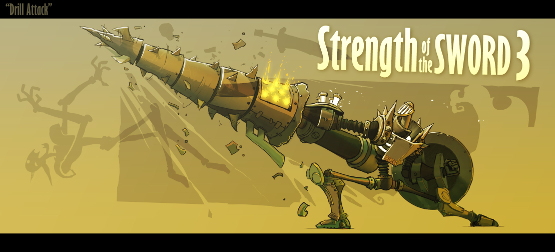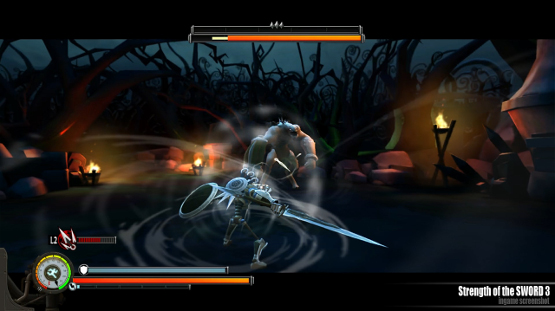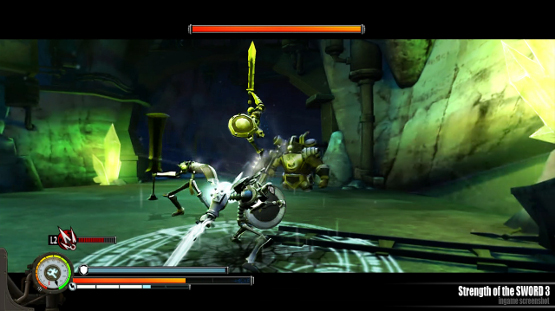Pit fighting – not the whole shebang about throwing as many Christians at lions as possible, and certainly nothing as glorious as a full-blown coliseum match, but the idea of one creature thrown into some type of arena and forcing them to duke it out until victorious or dead. Strength of the Sword 3 is such a game, played through eleven stages of multiple waves capped by boss stages. It’s a fairly short game with a lot of challenge and approaches the complexity of a one-on-one fighter.
The word “waves” is mentioned above but push aside the thoughts of Horde mode or Escalation. Strength of the Sword 3 takes the Sword part literally. Players are given the role of a golem sent from heaven to repel a swarm of goblin invaders. In this case, golem means steampunk sword robo. The first nine stages follow a predictable pattern: Two stages of three waves of enemies followed by a boss stage. The last two stages are a wave stage (with boss) and finally the final boss. Beating boss enemies allows players to unlock different predetermined swords or shields, which ultimately will require two playthroughs.
The point of Strength of the Sword 3 is to offer a challenge to players. Combat is first and everything else is secondary. This is odd because, while the plot might be ultimately forgettable, the presentation is rather well-done. Cutscenes use 2D cutouts to a multi-layered circular map to tell Strength of the Sword 3’s story. These are rather charming. In-game design lends to the cartoonish, but still polished enough to be interesting. Arenas, graphics and sounds are fairly average.
Enemy AI is touted as realistic, and indeed functions as one would expect three-on-one battles to function. Players will often get knocked into corners and then have the absolute gear-stuffing kicked out of them while they are down. Enemies will take advantage of a turned back frequently, and can get downright cheap in order to win (just like real life!). Tactically, the player must divide their enemies and then attempt to conquer before enemies can regroup. During boss fights, the game breaks down into looking for tells and countering accordingly. It should be noted the AI did seem to reconfigure itself to my play style, especially the last boss; who noticed my dependence on maneuverability and promptly backed himself into a corner to block off being struck from behind.
Aside from the slash, guard and dash functions, players have a variety of moves at their disposal with a decent division between moves requiring combos and moves which function as instants. Almost all moves require use of the game’s mana meter which may be charged by guarding and holding up. In a thankful moment of design, players may charge the meter in-between waves as the waves appear instead of the event scene locking out commands. This becomes a necessary tactic for survival.
In addition to weapons and shields, which determine the golem’s stats, subweapons are earned through combat and can be leveled up by defeating enemies. This levels the playing field a bit with health and mana packs, as well as ranged weapons. It should be noted that leveling up the subweapons appears to be random.
Combat would be great but is often held back by lacking controls and the constant lock-on to enemies. Often the golem would perform a dash across the arena with little input which depletes the dash meter and left me a sitting duck. I had no intention to utilize such a dash and yet the damn thing would still dash. Input problems were not uncommon, and the game works more often than it does not. Even though the dash function doubles as an evade maneuver, the player is not invincible and thus can run smack into an extended blade or striking hammer. The game also would enter slow-motion when the player is low on health to “help” determine which course of action the player should take next. The slow motion often didn’t help. There are also on-screen tips throughout the game, such as “hold ‘O’ to block” which would pop up during unblockable moves. The lock-on became troublesome during fights with larger enemies since dashing to evade telegraphed moves would not take the player out of the move’s range due to always dashing on a curve. Dashing away is not an option, as this could result in the enemy’s next move being masked by the camera angle. Said camera would often place itself behind rocks and other set pieces if players were too close to the outskirts of the levels.
Each level is score-based and graded on speed, defense, and offense. There are leaderboards and a Challenge Pit, the latter of which is a timed endurance mode against waves of enemies. Subweapons leveled up in the Pit carry over to the main game as well. There is some replay value here, and this is a game where practice and experience will triumph over rushing in and hitting things. Again, the game does offer a challenge.
Strength of the Sword 3 has a fairly decent set up, but the game is hampered by a lack of tuning with input, camera, and a fairly awkward dashing mechanic. If these things could be fixed, Strength of the Sword 3 could move above average fair and become a solid game. As it stands, Strength of the Sword 3 isn’t bad, but it isn’t good either.
-
Presentation is well done.
-
AI reacts to players and presents a challenge.
-
When everything works, there are some decent fights to be had.
-
Everything doesn’t always work.
-
Camera angles get awkward.










